The best pannier racks and pannier bags for bikes 2023: sturdy and high-volume options put to the test
Bike panniers are a great option to carry luggage if you're going touring or using your bike for commuting
- (opens in new tab)
- (opens in new tab)
- (opens in new tab)
- Sign up to our newsletter Newsletter


The best bike panniers will let you carry your luggage in comfort. But the first time you ride a bike with a rack and loaded panniers fitted, the sensation is somewhat alien. When full, panniers can add a substantial amount of weight to the bike and make any side-to-side rocking feel odd. You quickly get used to the added weight, although climbing out of the saddle may feel awkward; that's why the best touring bikes tend to have low gearing for climbs.
If you're carrying a heavy load, then placing the weight on your bike can certainly save your shoulders and back from undue stress – and you won't get the sweaty triangle associated with a backpack. Panniers can place the load lower down and may attach it more securely to your bike than even the best bikepacking bags, making for a more stable ride.
Pannier racks and panniers are popular among commuters, touring cyclists and anyone who needs to carry a substantial volume – they're great for day-to-day tasks like food shopping too.
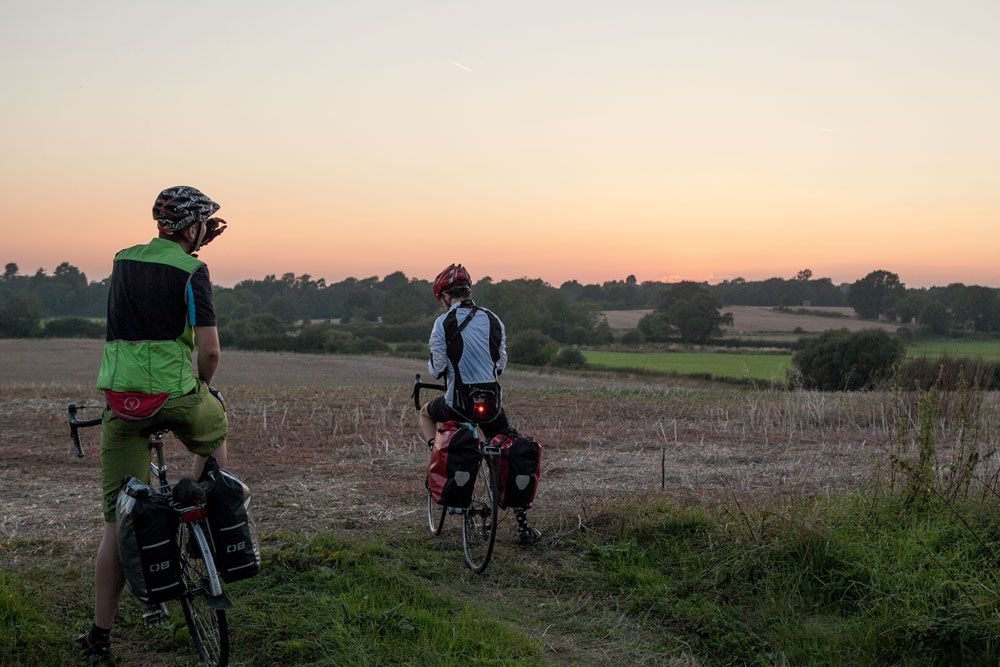
Panniers are usually fitted to the rear of the bike, but if you've got a lot to carry - maybe on your touring bike - then front panniers are an option too.
Pannier bags need to sit on pannier racks – and thus setting yourself up is a story of two halves. Here are our picks of the best pannier racks and best panniers, both front and rear. Scroll down to the end of the page for our buyer's guide to how to choose the best bike luggage.
Best rear racks

1. Ortlieb Quick Rack
Our expert review:
Specifications
Reasons to buy
Reasons to avoid
Ortlieb's Quick Rack is a revelation where racks are concerned. Not only is the initial installation exceptionally simple, it can be removed, or remounted, in less than 20 seconds.
It's suitable for 26” and 28” (limited suitability for 29” wheels – up to max. 2.35” tyre width). Extra accessories include mudguards and adaptors for bikes that don't have eyelets.
If you only have one bike the Quick Rack enables you to quickly transform it from a road warrior to a tourer, commuter or shopper at the drop of a hat. This makes transportation a breeze too. The hooks that remain on the bike when the rack is removed are hardly noticeable.
With two hanging levels, it comfortably accommodates panniers and a rack bag at the same time without one interfering with the other.
The rack looks tidy on the bike and is well-made, encouragingly it comes with Ortlieb's 5 year warranty. While it might be more expensive than the likes of Blackburn (opens in new tab) and Topeak (opens in new tab), our tester deemed its convenience and versatility well-worth the extra expense.
Read more: Ortlieb Quick Rack review

Specifications
Reasons to buy
Reasons to avoid
LifeLine's Alloy Rear Pannier Rack is an aluminium option for those looking to keep their costs down. With an RRP of just $33.99 / £22.99 and a maximum load of 25kg, it's one of the more affordable options.
Affordability doesn't guarantee quality though. When moving the bike rack from bike to bike while testing, we noted deterioration of the bolts. This is perhaps a rack you'll want to fit once and leave on the bike to avoid rounding the bolt heads, or maybe source better quality bolts.
LifeLine claim that the rack fits 'all wheel sizes from 26" to 700c'. We didn't agree; the arms lacked length to achieve a horizontal position on a few of our bikes.
There are eyelets for mounting reflectors and lights, though compatibility may pose issues here; we couldn't find anything to fit. The spring-loaded luggage bar is a nice addition and works well.
Overall, the Lifeline bike rack is an affordable, functional option if you know that you won't be moving it from bike to bike. If you think that it'll be swapped at some point, it might be worth investing in some better quality fixings.
Read more: LifeLine Alloy Rear Pannier Rack review

Specifications
Reasons to buy
Reasons to avoid
Topeak's Uni Super Tourist is an aluminium bike rack with stainless steel fittings. It's designed to 'fit most 24” to 29” wheel MTB and 700C touring bikes with disc brakes'. Out of the racks we tested, this one came out on top where compatibility was concerned; it fitted all the bikes that we tried it on.
The quality of construction and finishing is impressive. Unlike both LifeLine's and Decathlon's, the finish remained unmarked despite plenty of bike panniers being used on it.
With an RRP of $68.99 / £44.99, we'd say that this is definitely a value-for-money rack that should stand the test of time.
The maximum load of 26kg makes the bike rack ideal for anyone reliant on their bike for heavy shopping loads, keen tourers or those wanting a sleek system to carry a trunk bag; it features an MTX QuickTrack® plate which is compatible with any Topeak MTX TrunkBag or MTX rear basket.
Read more: Topeak Uni Super Tourist Rack review

Specifications
Reasons to buy
Reasons to avoid
The Decathlon ELOPS 100 bike rack is probably the cheapest option on the market. But just like LifeLine's bike rack, affordability doesn't always deliver compatibility, or quality.
The rack is a combination of aluminium and steel with a rather delicate finish. It would be advisable to use some insulating tape at pannier contact points if you want to prolong the aesthetical appearance of the rack.
The biggest drawback of this bike rack is its flatpack status. You'll need to be a little patient and happy to fettle if you are going to mount it yourself. On the plus side, all the tools you need are supplied.
We found compatibility to be on a par with the LifeLine Alloy Rack; it certainly doesn't fit 'all 24" to 28" bikes with frames equipped with inserts'.
The 10kg weight limit makes this a good choice for anyone wanting to carry light loads.
Read more: Decathlon ELOPS 100 Bike Pannier Rack review

Specifications
Reasons to buy
Reasons to avoid
The Expedition 1 Rear Rack is Blackburn's legacy product. Designed by Jim Blackburn in 1975, it's made from aircraft-grade aluminium, specifically for 700c or 29er wheels, but should suit most bike wheel sizes with 9mm QR axles. As the name suggests, this is a disc brake compatible bike rack, but there is also a standard rim brake version too.
It's hard not to love the simple mounting that the supplied quick-release skewer offers. It means that you can fit the rack to a bike that doesn't have mounting eyelets. Two different sizes of P-clips are also included for attaching the arms to the frame. If you swap bikes and have mounting points, it can be directly mounted to the frame too.
This is certainly a bike rack to invest in if you have a disc-brake bike and are reluctant to fettle with a rack that claims to 'fit-all'. The Expedition 1 will likely fit the vast majority of QR, disc-brake bikes with 700C wheels.
In addition to its simple mounting and reliability, it's well-made and comes with a lifetime warranty.
Read more: Blackburn Expedition 1 bike rack review
Also consider
Why you can trust Cycling Weekly Our expert reviewers spend hours testing and comparing products and services so you can choose the best for you. Find out more about how we test.
Our testing hasn't stretched to the following bike racks, so we can't comment on compatibility, ease of fitting, quality of construction or durability. However, they are certainly worth looking at if you are hoping to invest...
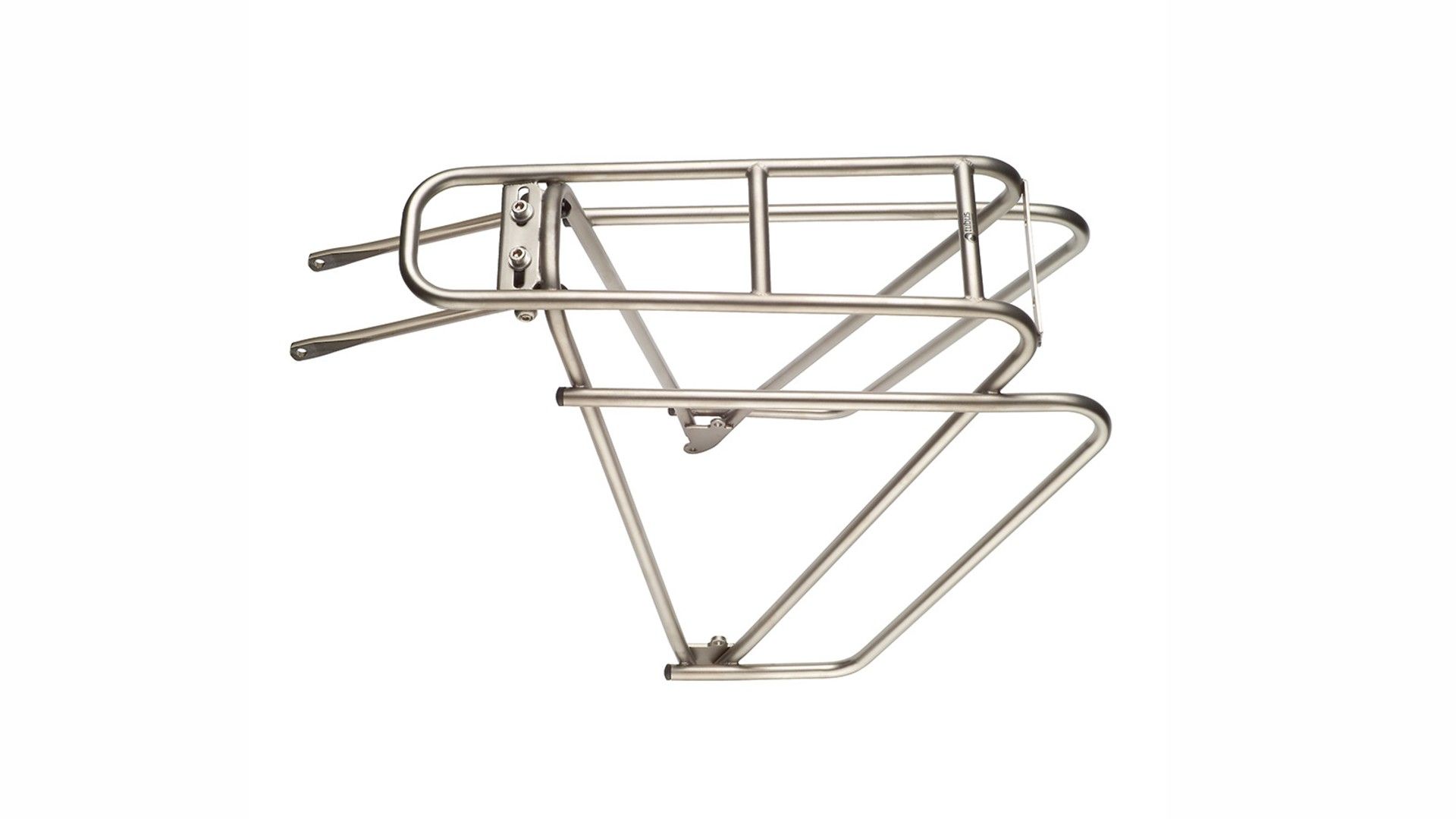
6. Tubus Logo Classic Stainless Steel Rear Pannier Rack
Specifications
Reasons to buy
Reasons to avoid
Tubus is a market leader and the brand produces high-quality bike racks for serious touring cyclists. This stainless steel rack is designed with a narrow top and lowered rails. Designed for 26" to 28" wheels, Tubus says that it's also a particularly good fit for smaller/ shorter frames. Pannier bags can sit on the lower rails, keeping weight closer to the ground while releasing space on top for strapping on a tent, roll matt or other kit.

7. Tortec Tour Ultralite Rear Rack
Specifications
Reasons to buy
Reasons to avoid
Made from aluminium tubing and weighing just 560g, the Tortec Tour Ultralite is one of the lightest bike racks on the market. The small rack is best for short tours, or commuters who would prefer panniers over rucksacks, although it can still take a claimed 25kg max weight. It's not disc compatible, but will work with most mudguard setups on 700c wheels.
Best front racks

8. Giant Rack It Front Rack
Specifications
Reasons to buy
Reasons to avoid
The simple front bike rack system allows for multi positioning on, according to Giant, all forks that are fitted with mounts, via a two bolt fixing (per side). Capable of taking a total load of 15kg, the 13mm aluminium tubing creates additional space for up to two side panniers.

9. Pelago Front Rasket Bike Rack Basket
Specifications
Reasons to buy
Reasons to avoid
Pelago says the Rasket offers the strength of a rack in the convenience of a basket. The multiple fixing points mean that you can use the front rack on almost any bike with wheel sizes from 26" to 29", with or without mount fixings, with rim or disc brakes (although compatibility with thru axles TBC). Compatible with side panniers too, the stainless steel Racket combines a rack and basket for a total load offering of 15kg (5kg each load point).
Best rear pannier bags
Once you've got your rack sorted, it's time to choose a pannier, or two, to attach to it.
When comparing prices, be sure to check whether you are getting a pair or a single pannier; many manufacturers sell single panniers, while others only sell pairs.

Specifications
Reasons to buy
Reasons to avoid
Ortlieb's Back Roller panniers are the choice of tourers worldwide for good reasons. The Back Roller Free boasts every feature that the long-standing Classic features: the Quick-Lock2.1 system that attaches to any pannier, tool-free adjustment, interior pouches, shoulder straps and an IP64 rating. So what's different? The latest Back Roller comes from Ortlieb's PVC-free line of products and is made of a polyurethane-coated polyester fabric.
Our tester felt that the fabric was slightly more malleable than that used on the Classic, and perhaps more vulnerable to abrasions. However, the overall performance was impressive and certainly wasn't affected by any scuffs. Indeed, the more malleable material made packing out the pannier easier.
LIke many of Ortlieb's products, these are built to last and also come with a 5 year warranty. This makes the initial $210 / £140 for a pair investment perfectly palatable.
Read more: Ortlieb Back Roller Free pannier review
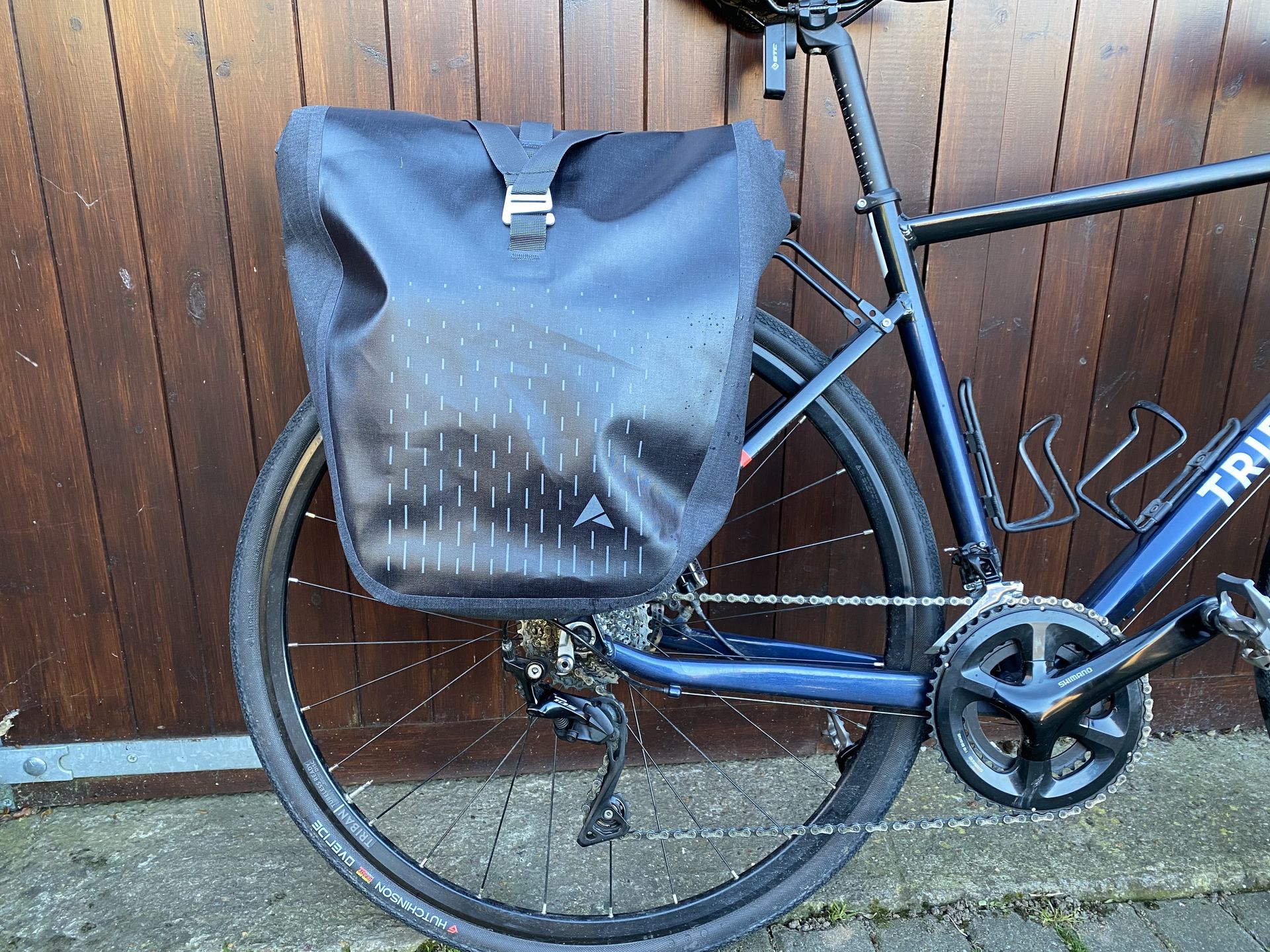
Specifications
Reasons to buy
Reasons to avoid
Altura is known for making practical kit that stands out at night; the Thunderstorm City Pannier is no exception. Its quality impressed hugely, rivalling other manufacturers for construction and waterproofing.
The roll-top closure with a single clasp is really easy to use, making the pannier ideal for anyone wanting regular, quick access to the pannier.
Reflective detailing is very good; those undertaking dark commutes will stand out in traffic.
Inside, there are two ‘open’ pouches and a zipped one, plus a key loop, while light padding protects anything in the pouches.
There's a single carry handle that is comfortable enough, though quite small. There's no supplied shoulder strap.
Given its durable, robust nature, the Thunderstorm City 20 shouldn't be confined to commuting duties; it would make for a decent touring pannier too, providing you are not trying to be too stealth.
Read more: Altura Thunderstorm City 20 Pannier review

Specifications
Reasons to buy
Reasons to avoid
Brooks' Scape range features a small and a large pannier. They tick the usual boxes that you would expect from Brooks: well-made, stylish and durable.
While the range is primarily targeted at adventure riders, the Scape Panniers won't be out of place on a commuting bike, or on the rack of someone simply doing errands.
There are no interior pockets but a sizeable, watertight exterior one goes some way to make up for this; it's a functional addition that many 100% waterproof panniers don't boast.
The carry handle is not designed for comfort; it's not much more than a piece of cord. There's no supplied shoulder strap, something to bear in mind if you considering investing.
The aesthetics are certainly subtle and stylish, with just a very small amount of reflective detailing on the sides.
These may be versatile but some commuters might consider the lack of carrying options and minimal reflectives a sticking point.
Read more: Brooks Scape pannier review

Specifications
Reasons to buy
Reasons to avoid
The Cube Travel Panniers are the only ones we tested that are sold as a pair. They are certainly best suited to commuters and those relying on a bike more than a car.
We wouldn't recommend them for touring any distance in uncertain weather conditions. While they are well made, they don't offer the waterproofing of Altura's or Brooks's. A water resistant shell comes with each pannier. It does a good job of fending off light rain, while increasing visibility. Anything heavier penetrates it.
We loved the pockets and pouches, both inside and out, though would have liked the outer zipped pocket to be a little larger.
Shoulder straps are included for both panniers and chunky buckles make these easy to use with gloved and/or cold hands.
They are roomy and well-shaped for anyone carrying bulky kit to the gym, workplace or back from the shops.
Read more: Cube Travel panniers review

Specifications
Reasons to buy
Reasons to avoid
Chrome prides itself on made-to-last kit for urban cyclists; the Urban Ex 2 Pannier is typical of the quality, robustness and style that it offers.
It's not as spacious as some, so be sure it offers the room you want before investing. Interior pockets and pouches offer excellent protection for electronic devices; a compact office is possible there. On the outside, there is daisy chain webbing to attach a D-lock to.
While we didn't find an official IPX rating on the website, we can confirm that it didn't let a droplet of water get to contents while we were testing; waterproofing is as good as the best.
Carrying options impressed hugely; two different options for carrying by hand, plus a robust, detachable shoulder strap. It's designed to be carried just as comfortably and conveniently off the bike as it is on it. These practical options, in our opinion, make the pannier one of the best for urban, office-based commuters.
The price is eye-watering, but with a lifetime warranty this is a buy-once-buy-to-last option for any discerning urban rider.
Read more: Chrome Industries Urban Ex Pannier 2.0 review

Specifications
Reasons to buy
Reasons to avoid
The Topeak Drybag DX is undoubtedly a pannier for anyone with a bulky load; its stated 25l capacity belies its seemingly bottomless form.
While reinforced side panels offer great protection for contents, they are removeable should you want a more pliable bag. It's 100% waterproof and seriously well-made.
We missed internal pockets and a shoulder strap but found the carry handle much more comfortable than something like Brooks'.
You may need to place the Drybag DX further back on your rack than other panniers; its depth could cause heel-striking.
Two colour options should satiate everyone; bright yellow for those wanting to stand out and black for those happy to blend in.
This is a single pannier purchase and we'd say be careful; fully loading it may make you feel a little unbalanced if you opt for just the one.
Read more: Topeak Pannier Drybag DX full review

Specifications
Reasons to buy
Reasons to avoid
If you are commited to commuting and errand riding in dry weather, the New Loox Varo Backpack could be worth considering. It's a well-made piece of kit that offers decent capacity, thoughtful internal storage and is comfy as a rucksack.
The lower Velcro strap (for securing the pannier to a rack) is a little fiddly and the Railtime clamp system isn't as easy to use as some quick release panniers. Securing shoulder straps (if they aren't detached) is necessary while riding too. All of these are niggles but not major issues. Overall functionality is good with quick access, external pockets, reflective detailing and a detachable neoprene laptop sleeve.
Our tester felt that the Varo Backpack wasn't a great option for rainy weather, though; it's 100% waterproof but no one wants to put a damp and dirty pannier on their back. Stowing the shoulder straps in the pannier while riding and carrying a cloth to clean the rear is an option if you happen to venture out in the rain.
Read more: New Loox Varo Backpack full review
Also consider

17. Vaude Aqua Back Rear Pannier
Specifications
Reasons to buy
Reasons to avoid
Like Ortlieb, Vaude is another gold standard brand of bike bags. The Aqua Backs, purchased as a pair, have a combined 48 litre capacity. According to Vaude they are climate neutrally manufactured, using durable, PVC-free tarpaulin. The roll closure allows for size customisation and a watertight closure, while a removable shoulder strap makes it easy to transport off the bike. The panniers weigh just shy of 2kg (for the pair) and should be compatible with most pannier racks.
Best front pannier bags
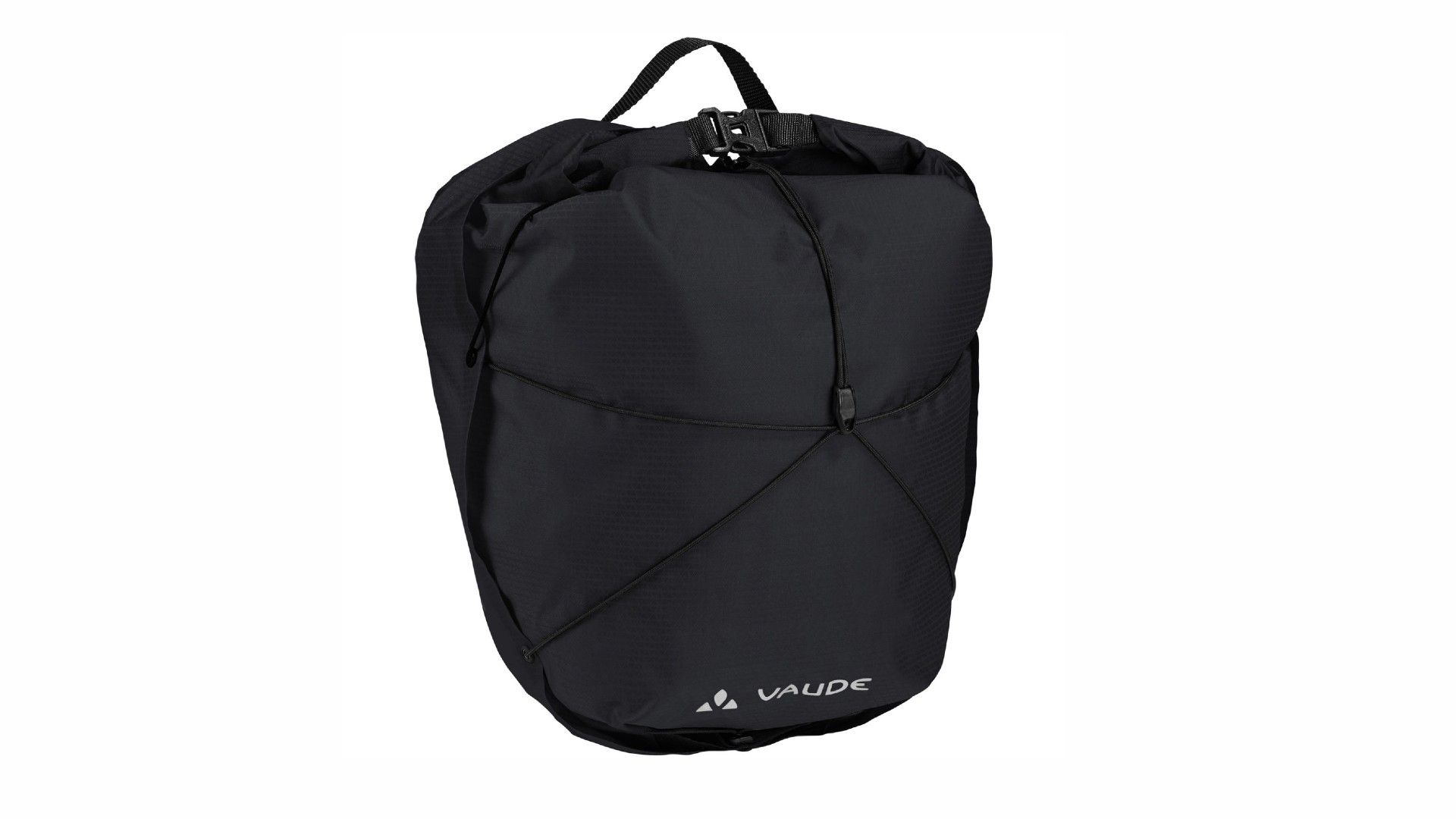
18. Vaude Aqua Front Light panniers (pair)
Specifications
Reasons to buy
Reasons to avoid
Vaude says the Ultralight set of two panniers is perfect for the adventurous rider thanks to its simplicity and robustness. With a 20 litre carrying capacity, the Aqua Front Light panniers are perfect for keeping goods safe and dry, with one main pocket and a smaller internal one for riding essentials. Water-repellent for all-weather use and a choice of lime green or black, both come with reflective logos and the QMR2.0 attachment system and a handy shoulder strap.

19. Ortlieb Front-Roller Plus Waterproof Pannier
Specifications
Reasons to buy
Reasons to avoid
Designed with riding up front in mind, Ortlieb says the Front-Roller Plus is especially durable and smaller than traditional rear panniers, ideal for carrying low weight to help keep weight distribution balanced. The 25 litre capacity bags are sold as a pair using the same QL2.1 fitting system as the rear panniers so can be interchangeable and promise to be fully waterproof.
Buyer's guide to bike panniers and racks
Will my bike fit a bike rack?
Firstly, not all bikes are designed to have pannier racks fitted with ease – so you'll need to ensure your bike is suitable before you go and buy a rack. A compatible bike will have eyelets for panniers near the tops of the seatstays and sometimes specific rack mount eyes next to the mudguard eyes above the rear dropouts.
If your bike doesn't have eyelets, you can buy mounting systems which attach directly to the frame and rear axle. Here it's important to pay attention to if the rack is or isn't compatible with your braking system, e.g disc brakes.
You can even buy seat post clamps with integrated bosses. Alternatively, there are loads of frame and saddle bags available now which are ideal for lighter-weight tourers and bikepacking. They have the advantage of not needing specific mounting points on your bike (although top tube feed bags may be designed to mount on the bosses that are a feature of many of the best gravel bikes).
Assuming you have a bike set up for a rack, or you know you can get a mounting system, it's time to choose a rack.
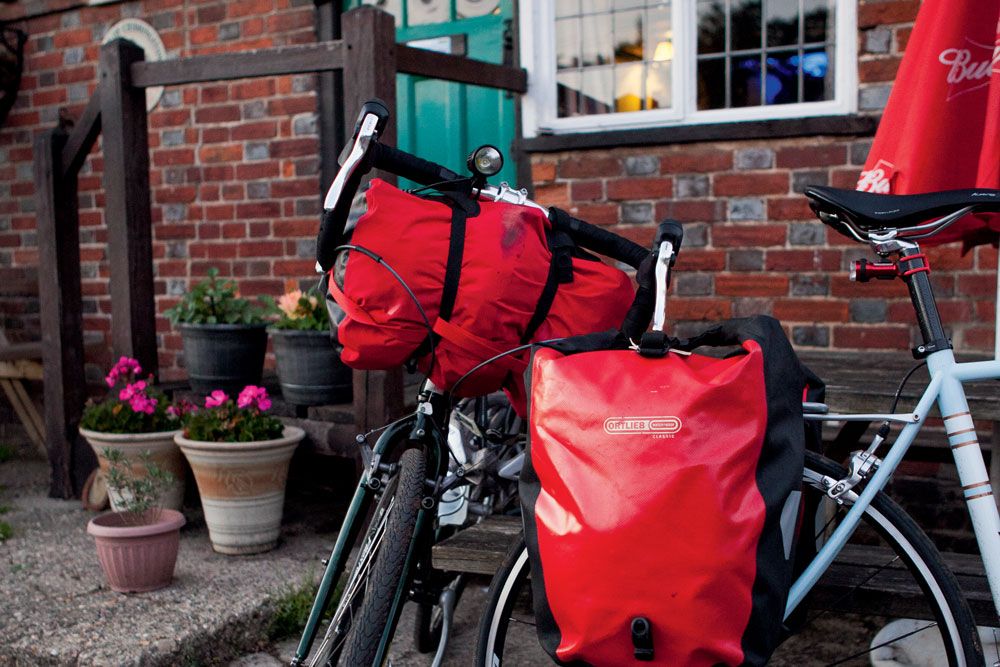
Do I need a front or a rear rack and panniers?
The most common style of pannier rack is fitted to the rear of the bike – but you can also opt for a rack at the front too. If you're carrying a moderate load it's probably easier to go with the rear.
If you're taking a lot of kit, opting for both and distributing it so that the greatest weight is at the back but there's some at the front will improve handling. It also makes the bike easier to push around and carry and less front-light if the rear is loaded so that the weight is close to or aft of the rear wheel.
Just having a front rack and panniers may affect your bike's steering, so should be avoided.
What are pannier racks made of?
Pannier racks are typically made from steel, aluminium or titanium. Aluminium is generally cheapest, and it's perfectly adequate. Steel is the strongest, though it can rust over time – unless you opt for stainless steel. Titanium is lightweight and it doesn't corrode – but it's more expensive.
What else should I look for?
The maximum weight that a pannier rack can withstand is a pretty crucial stat, so check this before buying.
Some bike racks offer more heel clearance than others. Purpose-designed touring bikes usually have long chainstays designed with panniers in mind, but if you're using a classic road bike with shorter chainstays (or your feet are on the larger side) then it's worth opting for one with more space allowance.
Many brands also supply add on mounting kits that help create a better fit with your bike – providing more heel clearance, adjusting the height at which the rack fits to offer a more natural centre of gravity, or with an extended mounting system to cater for pesky disc brakes.
One thing to be aware of is that while many racks will claim to fit 'all bikes' with specific wheel sizes, the ever evolving geometry of bike frames often means that they don't. The three we had on test recently certainly didn't 'fit all'.
What should I look for in the best bike panniers?
Your choice of pannier will be heavily influenced by intended use: durability, waterproofing, maximum weight/capacity and personal style all come into the equation.
Ortlieb is pretty much the market leader. The German-based manufacturer creates highly durable, totally waterproof panniers, with roll tops that keep the moisture out.
For those carrying a lighter load, there are plenty of panniers which can be removed from the bike and used as a standard backpack or shoulder bag, useful for shoppers and commuters.
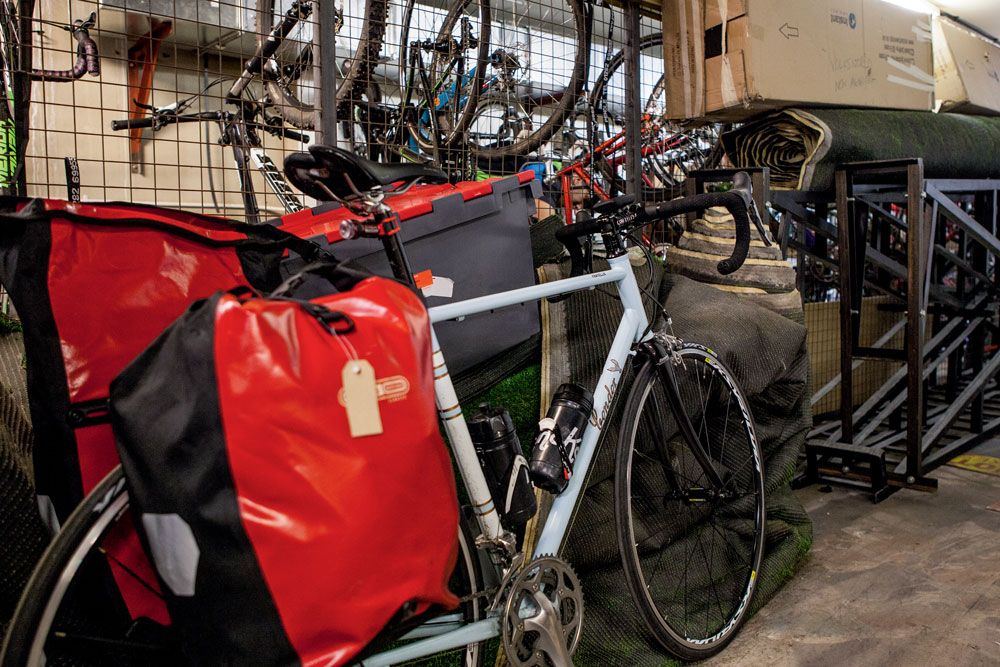
Where should I ride?
If you are looking for where to ride tour, check out our top eight places to ride in the UK or head off the beaten track with an adventure road or gravel bike ride tour.
Also check out our guide to absolutely everything you need to go bikepacking. Much of the list is the same for the well-prepared bike tourer.
Michelle Arthurs-Brennan is a traditional journalist by trade, having begun her career working for a local newspaper, where highlights included interviewing a very irate Freddie Star (and an even more irate theatre owner), as well as 'the one about the stolen chickens'.
Previous to joining the Cycling Weekly team, Michelle was Editor at Total Women's Cycling. She joined CW as an 'SEO Analyst', but couldn't keep her nose out of journalism and in the spreadsheets, eventually taking on the role of Tech Editor before her latest appointment as Digital Editor.
Michelle is a road racer who also enjoys track riding and the occasional time trial, though dabbles in off-road riding too (either on a mountain bike, or a 'gravel bike'). She is passionate about supporting grassroots women's racing and founded the women's road race team 1904rt.
Michelle is on maternity leave from July 8 2022, until April 2023.
-
-
 Closing the gap: David Gaudu emerges from Paris-Nice more confident than ever before
Closing the gap: David Gaudu emerges from Paris-Nice more confident than ever beforeThe Groupama-FDJ rider finished second overall at the Race to the Sun, but gained more than just the result
By Adam Becket • Published
-
 Goodbye lime: We need to talk about the Tour de France green jersey
Goodbye lime: We need to talk about the Tour de France green jerseyThere's change afoot at ASO's French races, with the combativity colour also undergoing a revamp
By Adam Becket • Published

